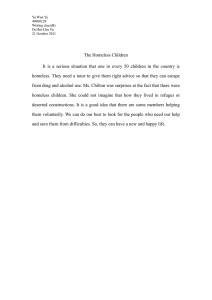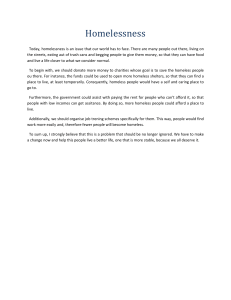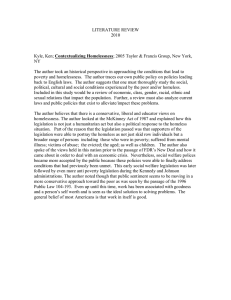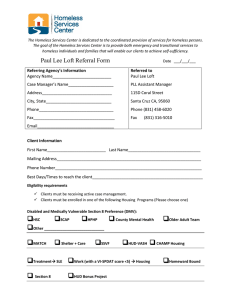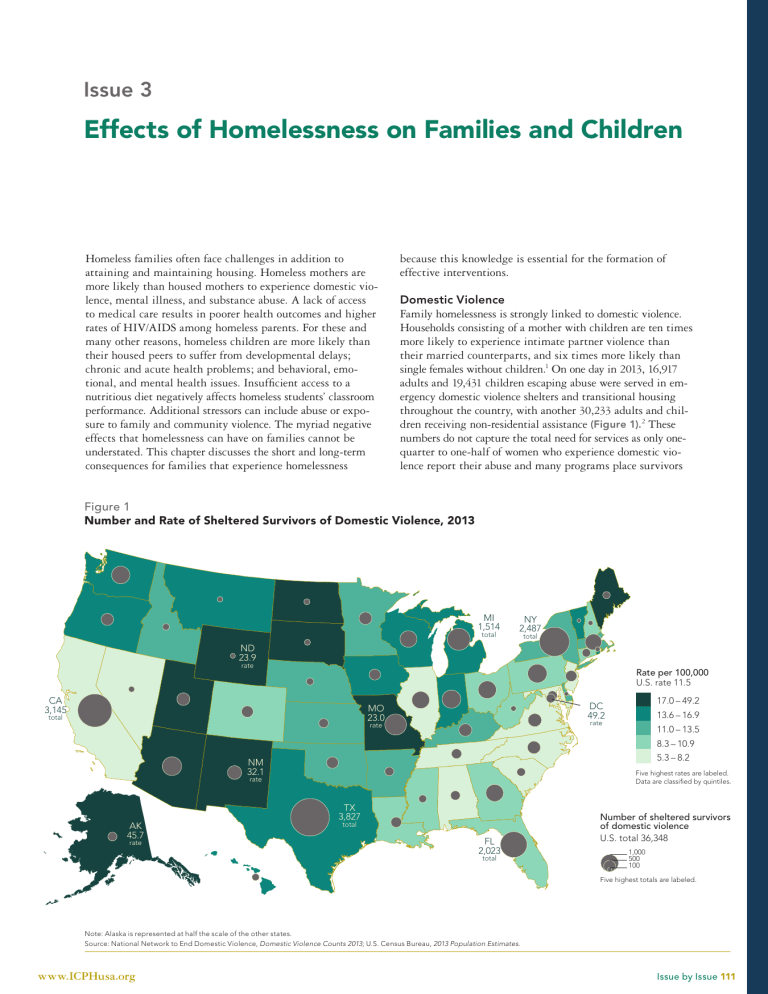
Issue 3 Effects of Homelessness on Families and Children Homeless families often face challenges in addition to attaining and maintaining housing. Homeless mothers are more likely than housed mothers to experience domestic violence, mental illness, and substance abuse. A lack of access to medical care results in poorer health outcomes and higher rates of HIV/AIDS among homeless parents. For these and many other reasons, homeless children are more likely than their housed peers to suffer from developmental delays; chronic and acute health problems; and behavioral, emotional, and mental health issues. Insufficient access to a nutritious diet negatively affects homeless students’ classroom performance. Additional stressors can include abuse or exposure to family and community violence. The myriad negative effects that homelessness can have on families cannot be understated. This chapter discusses the short and long-term consequences for families that experience homelessness because this knowledge is essential for the formation of effective interventions. Domestic Violence Family homelessness is strongly linked to domestic violence. Households consisting of a mother with children are ten times more likely to experience intimate partner violence than their married counterparts, and six times more likely than single females without children.1 On one day in 2013, 16,917 adults and 19,431 children escaping abuse were served in emergency domestic violence shelters and transitional housing throughout the country, with another 30,233 adults and children receiving non-residential assistance (Figure 1).2 These numbers do not capture the total need for services as only onequarter to one-half of women who experience domestic violence report their abuse and many programs place survivors Figure 1 Number and Rate of Sheltered Survivors of Domestic Violence, 2013 MI 1,514 total NY 2,487 total ND 23.9 rate Rate per 100,000 U.S. rate 11.5 CA 3,145 17.0 – 49.2 DC 49.2 MO 23.0 total 13.6 – 16.9 rate rate 11.0 – 13.5 8.3 – 10.9 5.3 – 8.2 NM 32.1 Five highest rates are labeled. Data are classified by quintiles. rate AK 45.7 rate TX 3,827 total FL 2,023 total Number of sheltered survivors of domestic violence U.S. total 36,348 1,000 500 100 Five highest totals are labeled. Note: Alaska is represented at half the scale of the other states. Source: National Network to End Domestic Violence, Domestic Violence Counts 2013; U.S. Census Bureau, 2013 Population Estimates. www.ICPHusa.org Issue by Issue 111 Effects of Homelessness on Families and Children on waiting lists due to underfunding.3 Domestic violence has a devastating effect on women and children nationwide, and its impact is exacerbated by gender disparities and other forms of inequality. Prevalence among low-income and homeless women is especially high; 91.6% of homeless mothers have experienced severe physical and/or sexual abuse during their lifetimes.4 Each year, approximately 15.5 million children are exposed to domestic violence, which can have long-lasting detrimental effects. Children who grow up in households where domestic violence is prevalent are more likely to abuse drugs and alcohol, attempt suicide, and have mental health problems. These children often experience violence themselves due to the intergenerational nature of the problem. Men who witnessed and experienced abuse as children are almost four times more likely to perpetrate violence as adults. Women who experienced childhood physical or sexual abuse are three times more likely to be victimized as adults.5 Women facing domestic violence experience high rates of depression, post-traumatic stress disorder, and physical health problems. These women are more likely to abuse alcohol and drugs (15 and nine times, respectively) than women who have not suffered from violence.6 Hospitalization and trauma recovery may necessitate leaves of absence from work, negatively impacting women’s ability to support their families. Nationally, survivors lose nearly 8.0 million days of paid work due to violence each year. Physical assault and rape result in an average of $4.1 billion in direct medical care and mental health bills and $1.8 billion in indirect costs of lost productivity and present value of lifetime earnings.7 Poverty status is linked to higher rates of domestic violence; women in the lowest pay category (earning less than $7,500 annually) and those living in economically disadvantaged neighborhoods experienced more than six times the rate of abuse of women earning over $50,000.8 The power and control present in abusive relationships can lead to isolation and financial dependency, which are especially detrimental for those with already limited incomes and poor credit histories. Without social and economic support, survivors are left with few alternative housing options. A Minnesota study revealed that nearly one in three women listed domestic violence as a primary reason for their homelessness. Almost half (47.5%) of homeless women in Minnesota reported staying in abusive relationships because they had nowhere else to go.9 Because battered women usually attempt to leave their abusers several times before successfully escaping, their children may experience multiple episodes of homelessness. Food pantry and soup kitchen records offer some evidence of the high prevalence and nature of food insecurity among homeless households. Approximately 1.1 million homeless households nationwide accessed shelter in 2012, and the following year, at least 759,000 sheltered and unsheltered homeless households received emergency food assistance through the Feeding America network of pantries, soup kitchens, and other partner agencies. If the definition of homelessness were expanded to include those who are doubled up, the number of homeless households receiving food aid would significantly increase. In 2013, 23.3% of Feeding America clients reported living with another person or family within the past year. More than half of the total 15.5 million families served in 2013 had to choose between having enough food and at least one other everyday necessity, such as utilities (69%), rent or mortgage (57%), or medical care (66%).12 Food insecurity is particularly harmful for children. Foodinsecure homeless and low-income children have worse physical and mental health, greater developmental delays, and poorer academic performance than their food-secure peers. Infants and toddlers are twice as likely to have fair or poor health, two-thirds more likely to experience developmental risk, and one-third more likely to be hospitalized if they are food insecure.13 Those with severe hunger experience almost twice the risk of chronic health conditions and over twice the risk of anxiety.14 Preschoolers facing food insecurity are almost two-thirds more likely to demonstrate behavior problems in the form of aggression, anxiety, depression, inattention, or hyperactivity.15 Food insecurity is also predictive of worse reading and mathematics scores among school-aged children.16 Food insecurity among pregnant mothers has negative health consequences for their newborn children, leading to low birth weights and greater risks for some birth defects.17 Mothers who are low-income or socially disadvantaged utilize the least prenatal care and have the highest infant mortality and premature birth rates.18 Breastfeeding mitigates demographically-based disadvantages; in one study, infants of immigrant mothers in food-insecure households showed fewer signs of negative health outcomes — such as reports from their mothers of fair or poor health, acute hospital admissions, and low weight for age —when they were breastfed.19 Food Insecurity Due to their low incomes and housing instability, homeless families and individuals experience higher levels of food insecurity— defined by the U.S. Department of Agriculture as limited or unstable availability of adequate amounts of nutritious food— than their housed, economically disadvantaged counterparts.10 While the prevalence of food insecurity among poor but housed families with children is well-documented (42.1% in 2013), national statistics on the number of food-insecure homeless families are not available.11 Issue by Issue 112 www.ICPHusa.org Effects of Homelessness on Families and Children The Health Status of Homeless Parents … While no data exist exclusively for adults in families, homeless persons experience three to six times the rates of serious illness and injury as the general population.20 Homelessness increases the risk and severity of certain medical conditions, including upper respiratory infections, heart disease, hypertension, gastrointestinal problems, and HIV/AIDS. Ensuring proper nutrition, which can help prevent many chronic diseases, is challenging for homeless parents. With limitations in income and access to nutritious foods, many typically eat diets high in fat, cholesterol, and sugar. Among homeless mothers, heightened risk of injury from physical violence, mental illness, and substance abuse pose serious health concerns.21 Abused women are more likely to suffer from depression. A Massachusetts study found that homeless mothers have three times the rate of post-traumatic stress disorder and more than twice the rate of major depressive disorders and substance abuse of those of women in the general population.22 Health disparities such as these can cause homeless parents to struggle to meet the needs of their families. … and Their Children Even before they are born, the wellbeing of homeless children is inextricably linked to that of their mothers. Half (50%) of homeless women had not had a prenatal visit in the first trimester of pregnancy, compared with 15% of women in the general population. Lack of prenatal care, coupled with substance abuse, negatively impacts babies’ health. Approximately one-fifth of homeless women report drug and alcohol abuse during pregnancy, which increases the risk of adverse birth outcomes such as low birth weight.23 The duration and frequency of homelessness itself also significantly predicts low birth weight.24 Homeless children exhibit more health problems and unmet medical needs than housed and low-income children. Homeless children suffer from chronic illnesses (including heart disease and neurologic disorders) and acute illnesses (such as minor upper respiratory infections) at twice the rate of the general ambulatory population.25 Due to poor nutrition, they are seven times more likely to experience iron deficiencies, which can lead to anemia.26 The most prevalent nutritional problem is obesity; a Los Angeles study found that 12% of the city’s homeless children under the age of five were obese.27 ICPH analysis of national Head Start data found that nearly two-fifths (38.3%) of children in the program who had experienced housing instability were reported as overweight or obese.28 Environmental factors strongly influence the health of homeless children. Babies born in low-income neighborhoods have lower birth weights than those in more affluent residential areas. Asthma —which affects one-third (33%) of homeless children in New York City shelters (compared with 13.0% of children citywide) —is endemic in old, crowded buildings with high exposure to smoke and other allergens.29 Children who are homeless not only have poorer overall health, but also limited access to ongoing health and dental care.30 Over one-fifth (22%) of children in New York City shelters lack essential immunizations and one-third (33%) www.ICPHusa.org of homeless families surveyed nationwide report that their children never visit a dentist.31 Mental Illness For mothers of children under the age of four, socioeconomic status is strongly associated with mental health; one-third (33.4%) of mothers in the lowest household income distribution experience depressive symptoms, compared with 9.2% of mothers in the highest fifth.32 Homelessness is further correlated with mental illness. Among homeless mothers in a Massachusetts study, the rate of psychiatric disability was almost three times higher than that of their housed counterparts.33 Maternal psychological distress is negatively related to homeless children’s emotional and behavioral health, although more research on long-term outcomes is necessary. Homeless families with mental illness experience more long-term homelessness than non-mentally ill families, as well as greater risk of separation of parents from their children. Mental illness also increases vulnerability to physical health problems by impairing families’ ability to maintain self-care and practice risk reduction.34 Substance Abuse Homeless mothers have a higher lifetime rate of substance abuse than that of housed low-income mothers, 41.1% versus 34.7%, which is twice that of women in the general population (20.3%).35 A Massachusetts study indicated that women who abuse substances have an increased risk of contracting sexually transmitted diseases and of developing anemia and heart disease. Homeless mothers who have ever injected drugs (8.3%, compared with 1.8% of low-income housed mothers) are in particular danger of contracting HIV.36 Substance abuse is also associated with violence; a Los Angeles County study revealed that homeless women who experienced either physical or sexual violence were three times more likely (24.3%) to abuse drugs and alcohol than women who were not victimized (7.9%).37 Abuse of substances complicates women’s ability to seek care for other health problems.38 Making matters worse, there is a shortage of comprehensive residential treatment facilities for mothers with children.39 Families living in poverty often use drugs and alcohol as coping mechanisms, with negative consequences for their children. Parental substance abuse is a contributing factor for between one- and two-thirds of children in the child welfare system.40 Babies born to mothers who abuse drugs and alcohol have a heightened risk of low birth weight and serious medical and neurobehavioral problems.41 HIV/AIDS Homeless women, mothers in particular, with their limited access to screenings and preventative care, have a higher risk of HIV infection than their housed peers.42 The effects of the disease (exorbitant health care costs and job loss from discrimination or extended absence) can increase the risk of homelessness for low-income families; up to 70% of persons living with HIV/AIDS report one or more episodes of housing instability.43 Conversely, homelessness is associated with HIV risk behaviors, including substance abuse; a Florida study reported that almost one-third (30.5%) of HIV-positive homeless clinic clients were injection drug users, nearly three times the national rate (11.7%).44 Homeless unaccompanied Issue by Issue 113 Effects of Homelessness on Families and Children youth, who are frequently exposed to high-risk environments and behaviors, are at two to ten times greater risk of HIV infection than their stably housed peers.45 Veterans Although the majority of homeless veterans are single adults (135,119, which represents 13.9% of total sheltered individuals), 3.1% (4,344) are adults in families (2.1% of sheltered families nationwide).46 Homeless veteran families are undercounted since many veterans live and request shelter separately from their children. Female veterans have two to four times the risk of becoming homeless as the general female population and are most at risk when they are heading fam- Issue by Issue 114 ilies with young children.47 Homeless veteran families are more than twice as likely as their nonveteran counterparts to have a male adult present (53.5% and 21.6%, respectively).48 Over half (53%) of homeless female veterans have at least one major mental disorder, which some studies attribute to their high rate (20% – 48%) of military sexual trauma.49 Almost three-quarters (74.2%) of homeless female veterans suffer from PTSD, which has been linked to social and behavioral problems in their children.50 Domestic violence rates are also high (19%) among all female veterans and close to twothirds (62.1%) of clients served by the Health Care for Homeless Veterans program have a substance use disorder.51 www.ICPHusa.org
